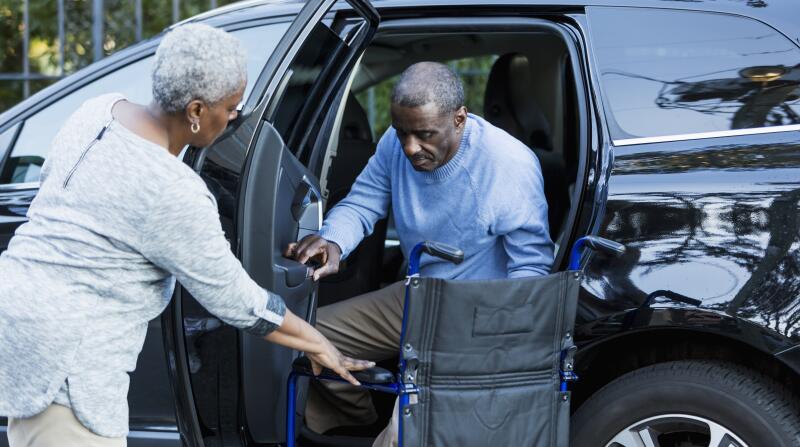10 Types of Assistive Devices for MS

Medically Reviewed By William C. Lloyd III, MD, FACS
-
 Your MS ToolkitWhen you have multiple sclerosis (MS), symptoms such as fatigue, weakness, and impaired vision can interfere with your daily life. Assistive devices are tools designed to overcome these obstacles. The tools range from electric can openers and easy-to-hold combs to sophisticated computer aids and specially adapted vans. But all share a common purpose: making your life easier.
Your MS ToolkitWhen you have multiple sclerosis (MS), symptoms such as fatigue, weakness, and impaired vision can interfere with your daily life. Assistive devices are tools designed to overcome these obstacles. The tools range from electric can openers and easy-to-hold combs to sophisticated computer aids and specially adapted vans. But all share a common purpose: making your life easier. -
 1. Cooking ToolsKitchen aids can make cooking more manageable when you have limited hand, wrist, and forearm strength. Examples include electric can and jar openers, lightweight pots and pans, and rocker knives (rounded blades used with a rocking motion for easier cutting).
1. Cooking ToolsKitchen aids can make cooking more manageable when you have limited hand, wrist, and forearm strength. Examples include electric can and jar openers, lightweight pots and pans, and rocker knives (rounded blades used with a rocking motion for easier cutting). -
-
 2. Housekeeping ToolsHousehold chores are less daunting when you have the right tool for the job. To minimize stretching and bending, you can use a long-handled duster, sponge, or reacher (a tool for grabbing objects from a high shelf or the floor). To reduce lifting, a wheeled cart for your cleaning supplies and laundry may help.
2. Housekeeping ToolsHousehold chores are less daunting when you have the right tool for the job. To minimize stretching and bending, you can use a long-handled duster, sponge, or reacher (a tool for grabbing objects from a high shelf or the floor). To reduce lifting, a wheeled cart for your cleaning supplies and laundry may help. -
 3. Bathroom AidsBathroom aids can make this essential room safer and more accessible. Examples include a shower chair, grab bar, or nonskid bath mat. Even something as simple as an electric toothbrush with a big handle or toothpaste in a pump dispenser can be helpful if you have a weak grip.
3. Bathroom AidsBathroom aids can make this essential room safer and more accessible. Examples include a shower chair, grab bar, or nonskid bath mat. Even something as simple as an electric toothbrush with a big handle or toothpaste in a pump dispenser can be helpful if you have a weak grip. -
 4. Grooming ToolsEasy-to-use clothing fasteners—such as Velcro tabs, elastic shoelaces, buttonhooks, and zipper pulls—can help you dress with success. Combs and brushes can be outfitted with large, padded handles for better grasping. A lighted magnifying mirror comes in handy if your vision is impaired by MS.
4. Grooming ToolsEasy-to-use clothing fasteners—such as Velcro tabs, elastic shoelaces, buttonhooks, and zipper pulls—can help you dress with success. Combs and brushes can be outfitted with large, padded handles for better grasping. A lighted magnifying mirror comes in handy if your vision is impaired by MS. -
 5. Walking AidsWithin 15 years of diagnosis, half of people with MS need some help with walking. Many benefit from using braces, a cane, crutches, or a walker for better balance and support. If you need more assistance, a wheelchair or motorized scooter is an option.
5. Walking AidsWithin 15 years of diagnosis, half of people with MS need some help with walking. Many benefit from using braces, a cane, crutches, or a walker for better balance and support. If you need more assistance, a wheelchair or motorized scooter is an option. -
-
 6. Driving ModificationsIf driving is a challenge, a physical or occupational therapist may recommend adaptive equipment for your vehicle. Examples include hand controls for the gas and brake, an easy-to-turn steering wheel, or a wheelchair transfer board. Before you get behind the wheel, you'll also need training in how to use special driving equipment safely.
6. Driving ModificationsIf driving is a challenge, a physical or occupational therapist may recommend adaptive equipment for your vehicle. Examples include hand controls for the gas and brake, an easy-to-turn steering wheel, or a wheelchair transfer board. Before you get behind the wheel, you'll also need training in how to use special driving equipment safely. -
 7. Reading ToolsVision problems are often an early symptom of MS. In some cases, lenses or magnifiers can help you read printed pages. Your prescription lenses can include added prism to eliminate double vision. When using the computer, consider a large-sized monitor and adjust the screen resolution settings that suit you best. You can also use the zoom feature on your operating system or web browser to enlarge text and images. For further help, a screen-reader program will speak aloud what's on the screen in a computerized voice.
7. Reading ToolsVision problems are often an early symptom of MS. In some cases, lenses or magnifiers can help you read printed pages. Your prescription lenses can include added prism to eliminate double vision. When using the computer, consider a large-sized monitor and adjust the screen resolution settings that suit you best. You can also use the zoom feature on your operating system or web browser to enlarge text and images. For further help, a screen-reader program will speak aloud what's on the screen in a computerized voice. -
 8. Writing AidsWriting aids help compensate for limited hand strength. Foam grips for pens and pencils help you grasp them securely. Adjustable office chairs and forearm supports (armrests that attach to your desk) help hold your body in a comfortable writing position.
8. Writing AidsWriting aids help compensate for limited hand strength. Foam grips for pens and pencils help you grasp them securely. Adjustable office chairs and forearm supports (armrests that attach to your desk) help hold your body in a comfortable writing position. -
 9. Typing AlternativesIf typing on a keyboard or using a mouse is difficult, technology offers several solutions. You might use an alternative input device, such as a large-key keyboard, touch pad, ergonomic mouse, joystick, or trackball. Or, you might use voice recognition software to control the computer with your voice.
9. Typing AlternativesIf typing on a keyboard or using a mouse is difficult, technology offers several solutions. You might use an alternative input device, such as a large-key keyboard, touch pad, ergonomic mouse, joystick, or trackball. Or, you might use voice recognition software to control the computer with your voice. -
 10. Scheduling ToolsMany people with MS have mild problems with memory and concentration. The calendar function on a computer or smartphone can help you remember important appointments and daily tasks. The memo function is convenient for grocery and to-do lists. Many of these apps can be voice-operated.
10. Scheduling ToolsMany people with MS have mild problems with memory and concentration. The calendar function on a computer or smartphone can help you remember important appointments and daily tasks. The memo function is convenient for grocery and to-do lists. Many of these apps can be voice-operated.
10 Types of Assistive Devices for Multiple Sclerosis
















